  |

|
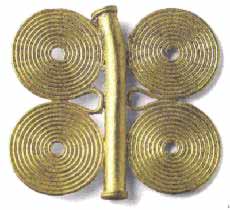
Fig 1 Gold
bead from Anavyssos.
8th century BC.
Athens, National Archaeological Museum, XP 1520, 6435.
|
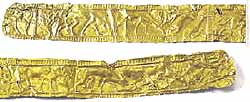
Fig. 2 Gold band from the Kerameikos.
8th century BC.
Athens, National Archaeological Museum, XP 1.
|
|
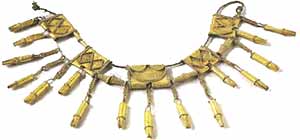
Fig 3 Gold
necklace from Spata.
8th century BC.
Athens, National Archaeological Museum, XP 1041, 6435.
|
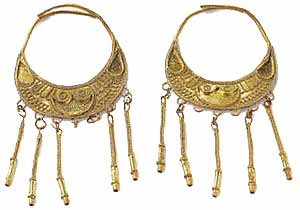
Fig. 4 Pair
of earrings from Eleusis.
8th century BC.
Athens, National Archaeological Museum, 10960.
|
 Fig.
5 Gold plaques from a pectoral ornament with filigree,
granulation and amber inlay. Fig.
5 Gold plaques from a pectoral ornament with filigree,
granulation and amber inlay.
8th century BC.
Athens, National Archaeological Museum, XP. 147.
|
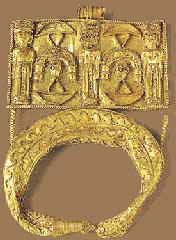
Fig. 6 Gold plaque from the Idaian Cave,
Crete.
Early 7th century BC.
Athens, National Archaeological Museum, XP. 674.
|
Geometric and Orientalizing periods
In the so-called dark ages (1100-800 BC) that followed the collapse of the
Mycenaean world, gold and silversmithing displayed neither the wealth nor the
imagination of the preceding centuries. Nevertheless, the tradition created
lived on, mingled with more recent influences from the North, primarily in the
bronze and iron jewellery - the noble metals are very rare - of the early
centuries (1100-900 BC), (Eig.1). Rings, hair spirals, bracelets and arched
fibulae recovered from Geometric graves in Attica were made in the simplest
possible form from wire or very thin sheet metal devoid of decoration.
Jewellery-making flowered anew shortly after 800 BC, as a
result of contacts with the more advanced civilizations of the East and Egypt.
This period, which is distinguished by oriental influences, spans the eighth and
seventh centuries BC. Funerary diadems with repousse decoration of geometric
motifs, animals or even humans, from the tombs in the Kerameikos (fig. 2); the
necklace (fig. 3), the earrings (fig.4) and the plaques decorated with filigree
and granulation, and inlaid with glass paste or amber, from the cemeteries at
Spata and Eleusis (fig. 5); the "earring" from the Idaian Cave, all
indicate that during the eighth century BC thriving goldsmithing workshops,
particularly in Attica and Crete, were producing works of exceptional artistry.
In the seventh century BC new centers of goldworking appeared
in the Aegean islands, where the arts of sculpture and pottery-making were
already, flourishing. Alongside Crete, Melos, Thera, and Rhodes can boast
veritable masterpieces.
The gold plaque with pre-dedalic figures, recovered from the
Idaian. Cave (fig. 6), attests the continuity of the Cretan workshop in the
early seventh century BC. The pectoral plaques with representation of the
mistress of beasts or dedalic protomes were fashioned in the Rhodian workshop.
The famous rosettes from Melos (fig. 7), their petals embellished with flowers,
griffins, insects, birds and bull heads executed in granulation and filigree
technique, bespeak the existence of some major local workshop, while the
"bees" from Thera (fig. 8), with the dedalic head so harmoniously
attuned to the insect's body, also merit attention.
|
|


|
Greece jewellery pages Copyright ©
by Add
Information Systems. (Greece)
|
|
  |

